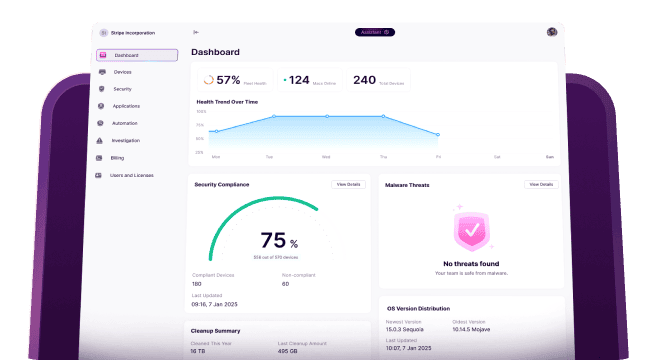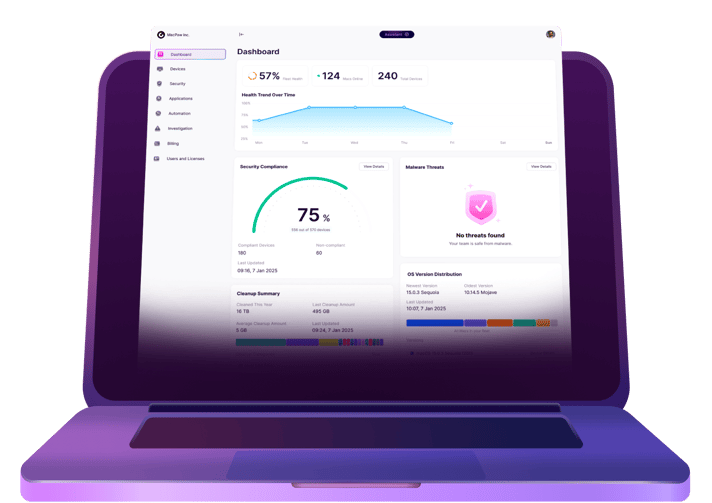I don’t need to tell you that how you use a computer for work is vastly different from how you use it at home. When you’re using a computer for personal reasons, you can do whatever you want. Sure, there are best practices for you to follow for security reasons, but whether you decide to follow them or not only impacts you only.
So, when it comes to managing devices, how do you make sure your users aren’t doing something that could put your entire environment at risk? An acceptable use policy (AUP) is one of the most important things that can help you with that.
In this article, I’m going to explain what an AUP is and why it’s so critical that your company has one. You’ll also read about what a comprehensive AUP should include and the best ways to implement it at your company.

What is an acceptable use policy?
Let’s start with the basics. Before we get into anything too deep, you need to understand what an acceptable use policy actually is.
While an AUP might be very official-sounding and feel overwhelming, in reality, it’s just a document. It outlines your company’s guidelines for how employees are expected to use the technology they’re provided with. But that doesn’t just include their work computers. A robust AUP should also include what they do on company networks and with other digital tools.
Listing all of this out helps establish multiple things. It allows employees to understand specifically what is and what isn’t allowed. But it can also help educate them on better ways to optimize their workflows.
Why is an acceptable use policy important?
While the benefits of an AUP might seem fairly obvious, I want to take a closer look at a few more perks of implementing a policy like this.
1. Keeping company assets safe
Clearly, an acceptable use policy is designed to keep your company’s assets safe. Writing it out can help you reduce the risk of data breaches and other attacks.
2. Staying compliant with regulations
An acceptable use policy gives you a chance to explain any local laws or regulations to your employees. It’s your job as part of the IT team to make sure your company is in compliance with all of these rules. But an AUP helps you educate your users and share in the accountability with them.
3. Promoting a productive work environment
By having a computer use policy, you’re able to anticipate the needs of your company. When you define what services employees shouldn’t use for security reasons, then you’re also able to provide a safer, approved alternative they can use.
What should an acceptable use policy include?
Now that you know the “why” behind having an acceptable use policy, it’s time to ask, “What needs to be covered in my AUP?” Well, here are a few ideas to help you get started:
- Who is this for and what does it include: It’s important to clearly define the objectives of the policy and who is required to follow them.
- Acceptable use: Outline what is deemed appropriate use of company resources, including internet access, email, and hardware.
- Prohibited use: Be very specific about what activities are forbidden. You should think about including things like downloading illegal content and social media harassment.
- Security requirements: Give an expectation for how a user should maintain the security of company systems. Explain that it’s their responsibility to follow and adhere to password and encryption policies.
- Privacy and monitoring: This is a big one to protect your IT team. Make sure all the employees know that their activity on company resources can and will be monitored.
- Consequences for non-compliance: Obviously, no one likes to think about the repercussions, but there need to be consequences if someone violates the AUP. Detailing these in your AUP can help employees understand the gravity and seriousness of any security threats.
How to implement a computer usage policy in your company
Before you can put a new policy into effect, there are a few steps that can help guide you to making it a successful launch.
1. Collaborate with stakeholders
Any policy that your team rolls out is bound to have a better adoption rate if it’s a collaboration across your entire company. Before you even begin to draft an AUP, it’s smart to present the idea to stakeholders. Get buy-in and any initial ideas from other departments like HR, legal, and even senior management.
2. Draft the policy
After you have buy-in from your stakeholders, you’re ready to go ahead and draft your AUP. Make it unique and really tailor the policy to the specific needs of your company.
3. Obtain approval
Before you communicate and start enforcing the policy to the rest of your company, take it back to your stakeholders and senior management. Give them a chance to review it and offer any revisions. This can help make sure you capture all of their thoughts prior to drafting the policy and gives you a chance to make edits based on new information that might have come up.
4. Communicate the policy
Now it’s time for your policy to go live. Share out the AUP with every employee and make sure they know its purpose and consequences. Also, ensure they understand the seriousness of the policy. You should also consider conducting training sessions to explain the AUP and give employees a chance to ask questions about it.
5. Review and update
Technology changes at such a rapid pace, and there are new systems launching every day. It’s a good idea to review and update your AUP periodically. This can help you stay active and on top of any new compliance issues that might arise.
Don’t be afraid to make changes to your policy often. In fact, your AUP should be a living document that’s agile so that it can keep up with your business’s changing needs. Encourage your employees to provide feedback on the policy. The same thing is true after you measure its effectiveness. If you’re consistently monitoring how the policy is working, then you’re able to fill in any gaps, thus making your company computer usage policy even stronger.
Drafting and implementing an acceptable use policy is an important part of any IT team’s management strategy. If you can establish clear guidelines, it will help keep your company safe and educate your employees on how to securely use their technology.







